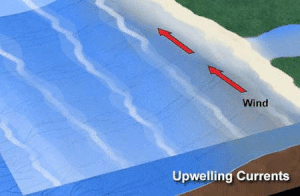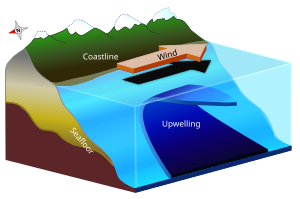Upwelling is an oceanographic phenomenon that involves wind-driven motion of dense, cooler, and usually nutrient-rich water from deep water towards the ocean surface. It replaces the warmer and usually nutrient-depleted surface water. The nutrient-rich upwelled water stimulates the growth and reproduction of primary producers such as phytoplankton. The biomass of phytoplankton and the presence of cool water in those regions allow upwelling zones to be identified by cool sea surface temperatures (SST) and high concentrations of chlorophyll a.[2][3]
The increased availability of nutrients in upwelling regions results in high levels of primary production and thus fishery production. Approximately 25% of the total global marine fish catches come from five upwellings, which occupy only 5% of the total ocean area.[4] Upwellings that are driven by coastal currents or diverging open ocean have the greatest impact on nutrient-enriched waters and global fishery yields.[4][5]
- ^ Upwelling National Ocean Service, NOAA.
- ^ Anderson, DM; Prell, WL (1993). "A 300 KYR record of upwelling off Oman during the late quaternary: evidence of the Asian southwest monsoon". Paleoceanography. 8 (2): 193–208. Bibcode:1993PalOc...8..193A. doi:10.1029/93pa00256.
- ^ Sarhan, T; Lafuente, JG; Vargas, M; Vargas, JM; Plaza, F (1999). "Upwelling mechanisms in the northwestern Alboran Sea". Journal of Marine Systems. 23 (4): 317–331. doi:10.1016/s0924-7963(99)00068-8.
- ^ a b Jennings, S., Kaiser, M.J., Reynolds, J.D. (2001) "Marine Fisheries Ecology." Oxford: Blackwell Science Ltd. ISBN 0-632-05098-5
- ^ Mann, K.H., Lazier, J.R.N. (2006) Dynamics of Marine Ecosystems: Biological-Physical Interactions in the Oceans. Oxford: Blackwell Publishing Ltd. ISBN 1-4051-1118-6

